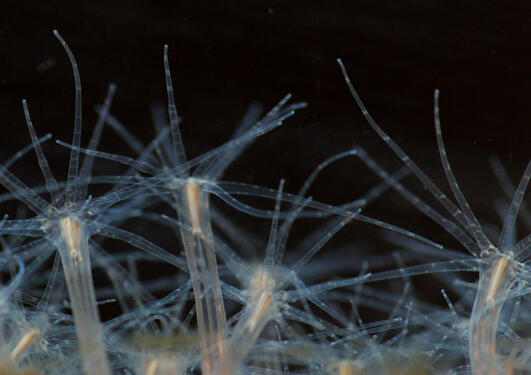Elusive stem cells revealed in a sea anemone
All animals need stem cells to reproduce, grow, and replace tissues through their lifetime. In a new article published in Nature Communications, lead author Paula Miramón-Puértolas and her colleagues discovered a population of stem-like cells in a sea anemone.

Main content
Stem cells can divide indefinitely, continuously replacing specialized cells around the body. While human stem cells have restricted potential, other animals possess stem cells that produce many different cell types, often granting these organisms high regenerative abilities. “Sea anemones can easily replace lost tissues, clone themselves and regenerate after bisection”, Steinmetz group PhD graduate Paula Miramón-Puértolas explained. “Identifying their stem cells is important to understand these abilities and, by comparing them to those of other animals, we can shed light on the evolution of stem cells and regeneration.” Using state-of-the-art gene editing techniques, the team have discovered a small cell population with extraordinary capacities in the sea anemone Nematostella vectensis.
To track down potential stem cell populations, the researchers used CrispR-Cas9 gene editing to highlight cells in the sea anemone’s body where stemness genes were expressed. “When I looked at my first reporter line under the microscope, I was shocked to see the sea anemone polyp light up like a Christmas tree, with beautifully shaped cells glowing all over its body”, Paula recalled. “My work sets the starting point to understand Nematostella stem cells”.
Originally focused on locating germline stem cells, which divide to produce sperm and eggs, the team soon understood that their findings had a broader significance than they had anticipated. The cells were not only contributing to the development of gametes, but also to neurons and other cell types. "The finding is really exciting because there is a good chance that these cells are the stem cells which the field has been looking for over the last 20 years”, group leader Patrick Steinmetz explained. “I think it will continue to have a big impact in the cnidarian stem cell field."
“Marine invertebrates are an endless source of fascinating biological questions, and we are just scratching the surface of their many extraordinary abilities”
- Paula Miramón-Puértolas
These results suggest that the newly discovered cell population can continuously develop into many different cell types, as expected from stem cells. The authors also found that these cells express genes such as Piwi and Vasa, which are commonly found in multipotent stem cells in other animals. Being very small and hidden in folds inside the animal’s body, the elusive cell population had likely been overlooked by generations of researchers. "You could ask why nobody discovered them before. I think it took Paula's dedication and her 'out-of-the-box' mindset to see the importance of what others might have discarded as background staining", Patrick said.
Further studying these cells and how they enable regeneration and longevity in sea anemones could provide new insight into coral biology due to the close relationship between the two animal groups. Coral research is increasingly important as scientists look for new ways to mitigate the devastating effects of climate change on coral reefs, and the work conducted in the Steinmetz group could inform novel stem cell-based approaches. “Marine invertebrates are an endless source of fascinating biological questions, and we are just scratching the surface of their many extraordinary abilities”, Paula concluded.

